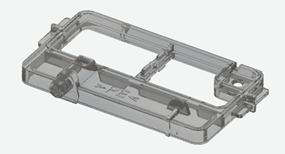Stop Hurrying Up to Wait

HP’s next generation of consumer and business inkjet printers remains under development. This frame component represents just one of many prototypes under consideration that Proto Labs has made for HP out of exotic engineering resins that will be used in the final product. Image courtesy of Proto Labs Inc.
January 16, 2018
“Hurry Up and Wait” seems the motto for many new product development projects. Honchos, clients and, likely, your own impatience urge you to speed things up. Still, you have stretches waiting in the dark for some component to appear so that you can test your idea. Rapid prototyping can pare back development lags, but RP done with collaborators can help transform your process dramatically. That's the lesson found at the other side of today's Check it Out link.
You'll also learn that even the big guys with seemingly every conceivable resource you covet need a hand now and then. See, this team of engineers and designers at HP working on the next generation of inkjet printers and cartridges needed help reducing their design cycle time. Like any development team, they produce multiple design iterations. They need molded prototypes to test out. The quicker the better.
 HP's next generation of consumer and business inkjet printers remains under development. This frame component represents just one of many prototypes under consideration that Proto Labs has made for HP out of exotic engineering resins that will be used in the final product. Image courtesy of Proto Labs Inc.
HP's next generation of consumer and business inkjet printers remains under development. This frame component represents just one of many prototypes under consideration that Proto Labs has made for HP out of exotic engineering resins that will be used in the final product. Image courtesy of Proto Labs Inc.Catch Number One: The parts they're developing come in direct contact with ink. Consequently, the best-case scenario calls for injection-molded prototype parts that match the materials used in the shipping products. Machined parts, the norm, have long lead times and aren't quite the same.
Catch Number Two: The end use parts will be made of exotic engineering resins that provide high heat deflection. This means customized versions of thermoplastics such as PET (polyethylene terephthalate), a glass-built PETG (glycol-modified PET) as well as other plastics and blends.
That's a tall order. The online case study “HP Slashes Design Cycle Time with Rapid Manufacturing” reports on how this HP team worked with Proto Labs to overcome the catches. They made parts in the end use resins and reduced prototype to injection-mold cycle times, including delivery, from six weeks or so to no more than 15 days.
And there's more to this quick read. For example, both applications engineers and mold technicians at Proto Labs assessed the custom materials to make sure that they could mold the parts without wasting everyone's time.
There's some tantalizing details on Proto Labs' automated design for manufacturability analysis tool delivering a quote in a couple of hours rather than days for a manual quote. It also enabled multiple iterations within different designs. An HP engineer from the project is quoted saying things you'll want to know.
“HP Slashes Design Cycle Time with Rapid Manufacturing” is good stuff. Hurry up and wait no more. Hit this link and read it yourself.
Thanks, Pal. – Lockwood
Anthony J. Lockwood
Editor at Large, DE
Subscribe to our FREE magazine, FREE email newsletters or both!
About the Author
Anthony J. Lockwood is Digital Engineering’s founding editor. He is now retired. Contact him via [email protected].
Follow DE







